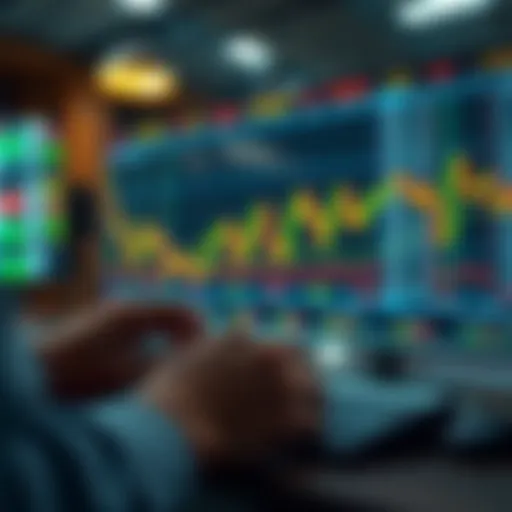Investing in Gold and Silver: A Comprehensive Guide
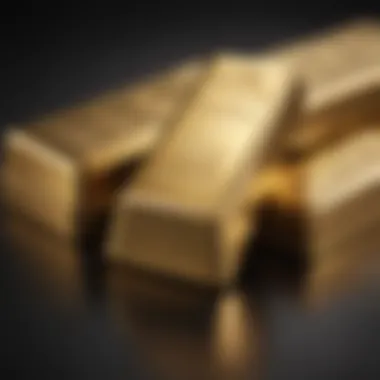
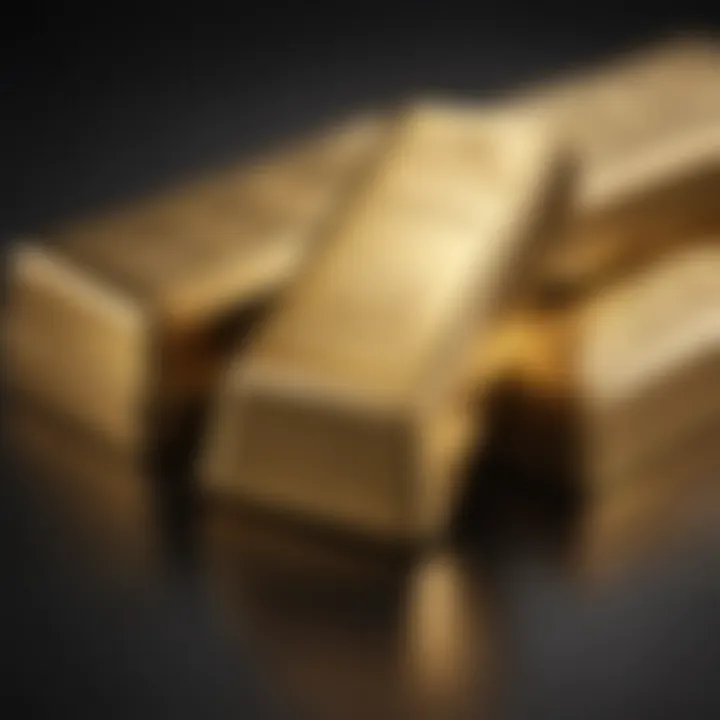
Intro
The allure of gold and silver has captivated humankind for centuries, serving not just as ornamental trinkets but also as significant forms of investment. Many investors find themselves pondering why these precious metals hold such a prominent place in portfolios worldwide. The subtle glimmer of gold or the lustrous sheen of silver goes beyond mere aesthetics; they represent a form of financial security and stability, especially in times of economic turmoil.
As we navigate through the intricacies of investing in these commodities, it becomes clear that understanding the fundamental principles is crucial. This article attempts to break down the various facets involved in making informed investments in gold and silver, shedding light on their historical roles, market dynamics, and the potential advantages they offer in tough financial climates.
Now, let’s delve into the foundational concepts that form the backbone of investing in these precious metals.
Foreword to Precious Metals Investment
Investing in precious metals, specifically gold and silver, has long been regarded as a time-honored approach to wealth preservation and growth. In an era where financial markets can swing wildly, these metals stand out as stabilizing forces that have value across centuries and cultures. Understanding this investment vehicle is essential for savvy investors aiming to diversify their portfolios and hedge against unpredictable economic fluctuations.
Defining Precious Metals
Precious metals include gold, silver, platinum, and palladium. These elements hold intrinsic value due to their rarity, beauty, and demand, both industrially and as investments. Gold, often viewed as a universal store of value, has been used for currency and jewelry for thousands of years. Silver, on the other hand, has both monetary worth and practical applications, such as in electronics and photography.
The primary distinction between precious metals and other investment assets, such as stocks or real estate, lies in their tangible nature. Having physical assets can offer a sense of security in times of economic uncertainty, a trait that resonates with many investors. In essence, precious metals are not merely commodities; they bear a historical significance that adds to their value.
A Brief History of Gold and Silver as Currency
Gold and silver have been entwined in the fabric of human economy for millennia. Their use as currency can be traced back to ancient civilizations, like the Egyptians and Mesopotamians, who recognized gold's luster and durability as suitable for trade. Silver coins started circulating around 600 B.C. with the Lydians, setting a precedent for standardized currency.
Over time, kings and empires minted coins featuring their likenesses, marking significant moments in history. Even in modern economies, gold and silver-backed currencies existed until the mid-20th century, establishing trust and stability in financial systems.
Both gold and silver carry profound historical narratives, reflecting not just wealth but cultural values and technological advancements throughout the ages.
The transition from precious metal-backed currency to fiat money illustrates not just a change in economic structure but also a psychological shift among investors. While paper currency may dominate transactions today, the intrinsic value of gold and silver remains undeniable, serving as a buffer against inflation and economic crises.
In summary, grasping the significance of precious metals—both as definitions and historical contexts—lays a solid foundation for understanding their role in today's investment landscape. As we delve deeper, the next sections will explore critical economic factors that underscore the importance of gold and silver investment.
The Economic Climate: Why Consider Gold and Silver
In the intricate world of investing, the underlying economic climate plays a crucial role in shaping investor choices. Gold and silver have maintained their allure as safe havens during turbulent times. The volatility of financial markets and the unpredictability of future trends make these metals worthy contenders for insertion into a diversified investment portfolio. In particular, their historical roles as enduring forms of wealth help establish them not only as tangible assets but also as psychological comforts.
Moreover, these metals serve as a hedge against economic fluctuations, inflation, and shifts in investor sentiment. As the saying goes, "When the going gets tough, the tough get buying gold and silver." Understanding the significance of inflation and currency depreciation, alongside global economic events, enables investors to appreciate why these natural resources remain pivotal in today’s financial landscape.
Inflation and Currency Depreciation
The specter of inflation is like a shadow lurking behind every economic report. When prices rise faster than wages, the value of money diminishes. In such instances, investors often look to gold and silver as reliable stores of value. Unlike fiat currencies that can be printed at will, precious metals come with limited supply. This inherent scarcity protects their worth when the purchasing power of currency dwindles.
Historically, during periods of high inflation, gold has shown a tendency to rally. For instance, during the 1970s oil crisis, as inflation surged in the US, gold prices climbed considerably. This historical precedent has led many to conclude:
- Gold and silver can maintain their value even as paper currencies lose their purchasing power.
- Precious metals act as a safeguard against unpredictable economic scenarios.
In the investment ecosystem, responding to inflation through physical commodities can often feel like a smart strategy. When one chooses to invest in gold or silver, they’re not merely buying shiny objects; they’re positioning themselves against the current economic tide.
Global Economic Events Impacting Precious Metals
What happens on the global stage doesn't just affect headlines but ripples down through the markets and impacts individual investments. Geopolitical events, trade wars, or changes in fiscal policies can sway gold and silver prices like a boat in choppy waters.
For instance, when political instability arises, or when major economies implement detrimental trade tariffs, precious metals often become more appealing. They are perceived as safe harbors amid uncertainty. Investors tend to flock towards these commodities during downturns or anticipated crises, pushing up demand and prices.
Several key factors stand out in analyzing the effect of global events on precious metals:
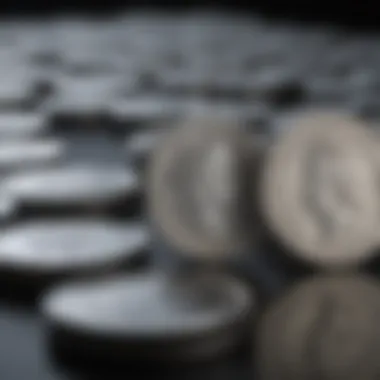
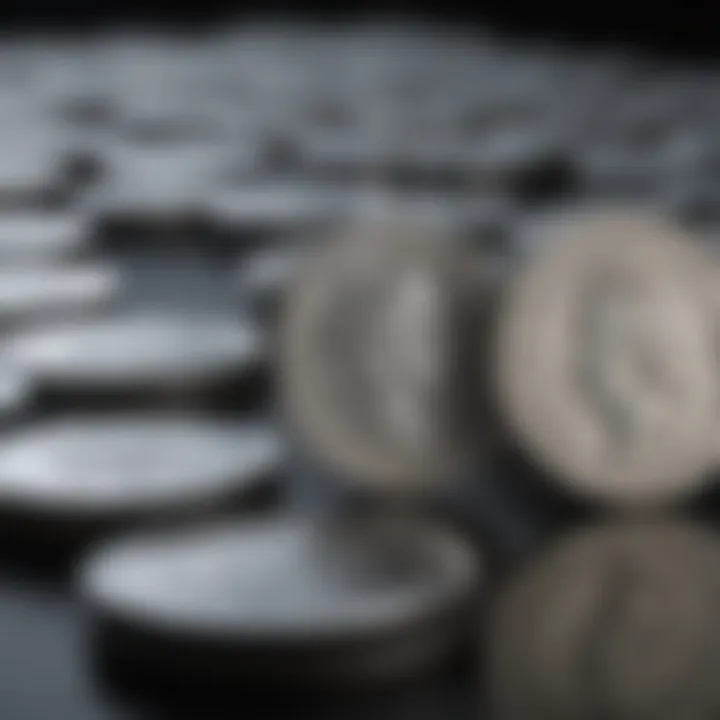
- Crisis Situations: Wars or political upheaval can result in increased buying of gold and silver as a “risk-off” strategy.
- Regulatory Changes: Government actions such as sanctions or manipulation of interest rates might drive investors toward precious metals.
- Economic Indicators: Reports like unemployment rates or construction spending can influence confidence levels, thereby affecting gold and silver as alternative investments.
Historical trends show that the demand for gold and silver often spikes during adverse global conditions, demonstrating their robust nature as a refuge in financial storms.
In summary, understanding how the larger economic climate and specific events influence gold and silver prices allows investors to make more informed decisions. The roles of inflation and current events in dictating market trends illustrate that these metals are not only investment options but also symbols of financial stability in uncertain times. As the narrative of the economy unfolds, investors who keep a keen eye on these factors could very well find gold and silver to be more than just mere metal but vital components of a resilient portfolio.
Investment Strategies: Building a Portfolio with Gold and Silver
When it comes to investing, having the right strategy can make all the difference between sinking or swimming. Specifically, investment strategies involving gold and silver have gained traction among astute investors looking for stability amid market volatility. This section aims to shine a light on how these precious metals can become cornerstones of a robust investment portfolio.
Gold and silver don't just sit in a vault; they embody a wealth preservation tactic, particularly in times of economic unrest. They often respond differently to various market conditions compared to traditional stocks and bonds, making them an essential part of many investment frameworks. But before diving headfirst into the shiny glimmer of these metals, it is crucial to understand how to allocate them wisely and maximize their potential benefits.
Determining the Right Allocation
When you're piecing together an investment portfolio, allocation acts as the glue that holds your strategy together. So how do you determine the right allocation for gold and silver? It's not a one-size-fits-all formula, but rather a blend of your financial goals, risk appetite, and time horizon. Here’s a breakdown of key considerations:
- Investment Goals: Decide if your objective is capital appreciation or wealth preservation. Gold tends to be more stable, while silver can see sharp fluctuations, potentially yielding higher returns—but also higher risks.
- Risk Tolerance: Consider how comfortable you are with market ups and downs. Those averse to risk might favor a larger portion of gold, while those taking a bolder stance could opt for more silver to balance out their holdings.
- Market Conditions: Pay attention to the economic climate. During times of uncertainty or inflation, increasing your allocation to gold could provide a safer harbor, whereas in a recovering economy, silver's industrial demand might shine through
"Successful investing is about more than just picking a good stock or metal. It’s about building an authentic strategy that stands the test of time."
- Practical Percentage: Many seasoned investors suggest allocating anywhere from 5% to 20% of your portfolio to precious metals, depending on individual circumstances. It’s still a delicate dance; overcommitting to metals could infringe on opportunities in other asset classes.
Diversification and Risk Mitigation
In the investment world, the saying "don't put all your eggs in one basket" rings true, especially when it comes to precious metals. Diversification is a well-trodden path for minimizing risk and enhancing returns, and gold and silver can play pivotal roles in achieving that balance.
- Asset Uncorrelation: Gold often moves in a different direction than stocks and bonds. This factor can act as a buffer during economic downturns or financial crashes. On the other hand, silver might correlate more closely with economic growth. By holding both, you can smooth out your portfolio's performance.
- Liquid Assets: Both gold and silver are liquid assets, meaning you can access cash relatively quickly if you need to rebalance your portfolio or cover unexpected expenses. This liquidity feature is particularly significant during turbulent times when financial resources are essential.
- Hedging against Inflation: Both precious metals have historically served as hedges against inflation. When currencies lose their purchasing power, gold and silver typically hold value or even appreciate, providing some level of protection.
To sum it all up, building a portfolio with gold and silver is an art married to science. Each investor’s canvas is unique, necessitating tailored strategies to suit individual motives and market conditions. By diligently determining your allocation and embracing diversification, you can set a course for investing that not only navigates through storms but also positions you to seize opportunities as they arise.
Comparative Analysis: Gold vs Silver
When it comes to precious metals, gold and silver often steal the spotlight as two of the most sought-after investment options. Each metal has its own unique qualities and benefits, making a comparative analysis not only valuable but also essential for potential investors. By understanding how gold and silver stack up against each other, investors can make more informed decisions based on their individual financial goals and market perceptions.
Market Demand and Supply Dynamics
Gold and silver operate in interlinked markets, yet their supply and demand characteristics often diverge significantly. Gold is primarily viewed as a store of value and a hedge against inflation. Central banks worldwide hold significant quantities of gold, which continually supports its value. In contrast, silver offers a dual role as an investment and an industrial metal. About half of the annual silver demand comes from industrial applications, such as electronics and solar panels, which can greatly affect its market dynamics.
The market demand for gold may surge during economic uncertainty, with investors flocking to it like bees to honey. Conversely, silver tends to react more to economic growth signals, given its broader application in industry. For instance, when economies pick up, silver's industrial demand might push prices higher; on the flip side, during economic downturns, its investment demand may wane as manufacturing slows.
Factors to consider:
- Economic Vibes: When the economy falters, gold typically shines brighter, while silver often holds its ground but may not soar at the same pace.
- Central Bank Activities: With gold’s inclusion in reserve assets, central banks' buying patterns can heavily influence market dynamics.
- Investment Interest: Public interest and perception affect demand. Periods of heightened investment interest often see gold favored over silver due to its historical reputation.
Price Fluctuations and Historical Trends
Over the years, gold and silver have displayed distinct price trends, often influenced by broader economic events. Gold’s price is generally more stable in comparison to silver’s. This stability can be attributed to gold’s position in the global market. Its intrinsic value is well acknowledged and it consistently moves in response to shifts in global economic conditions.
On the other hand, silver is notorious for its volatility. Its prices can shoot up dramatically or plummet within short time spans. For example, in the wake of the 2008 financial crisis, while gold peaked, silver saw a significant drop before regaining momentum due to industrial demand. Such volatility can be a double-edged sword; it can lead to substantial gains, but also expose investors to higher risks.
Historical trends to ponder:

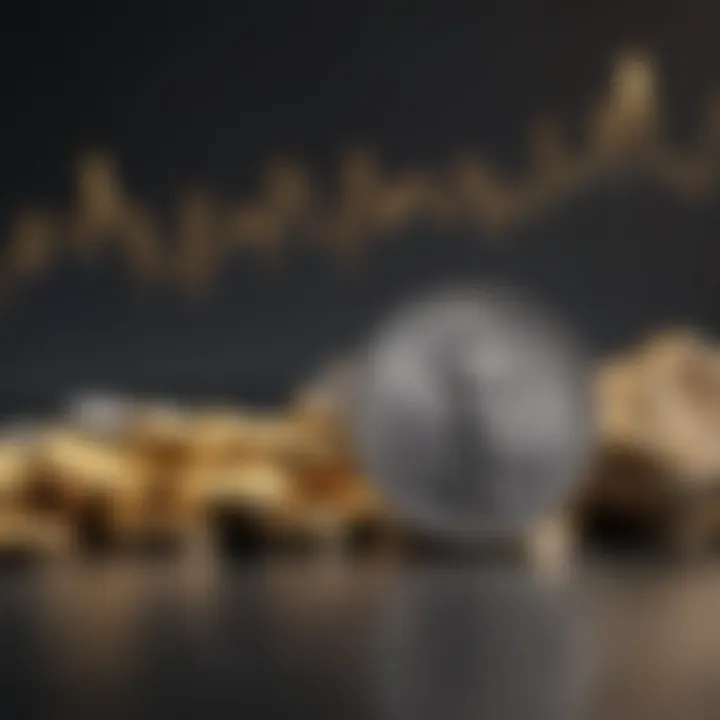
- Long-Term Performance: Gold has had a smoother ascent over decades, maintaining its status as a safe-haven asset, whereas silver has shown more conspicuous peaks and troughs.
- Market Reaction to Events: Key events like the 2020 pandemic triggered price reactions in both metals. Gold surged, reflecting its safe-haven nature, while silver, despite a strong recovery, showed more instability.
- Investment Philosophy: Investors typically flirt with gold when they seek stability, while silver may attract those looking for a gambit with a potentially higher reward.
The nuances in demand, supply, and price behavior between gold and silver reflect their roles in both the investment realm and the global economy, making them both worthy of consideration in any investment strategy.
The Role of Gold and Silver in Economic Downturns
In times of economic instability, the role of gold and silver as investment options comes to the forefront. Both metals have a long-standing reputation for acting as safe havens when markets falter. During such downturns, the value of traditional investments, like stocks and bonds, can plummet, while the allure of precious metals often becomes ever stronger. The importance of understanding how these metals perform during tough economic times cannot be overstated, as they often serve not just as investment choices, but as strategic shields for one’s financial well-being.
Historical Evidence of Performance
History tells a compelling tale about gold and silver's resilience in downturns. For instance, during the 2008 financial crisis, gold prices surged. While the S&P 500 index took a dive, gold became a beacon of stability. Between 2007 and 2012, the price of gold increased more than triple, reaching heights that shocked many investors. The same trend is observed in other economic crises such as the 1970s stagflation period, where gold and silver saw significant gains.
It's not just a mere coincidence. Historical performance suggests that investors flock to these metals during troubling times, which further drives their prices up. Furthermore, central banks, during economic downturns, often opt for gold as part of their monetary policy strategies. This historical evidence underlines the importance of including gold and silver in one’s investment approach—there’s a legacy of resilience that can't be ignored.
Psychology of Investors During Crises
The psychology surrounding investments in crises is fascinating. Fear often leads the way in decision-making, whether it be panic selling or a rush toward perceived safe assets. Gold and silver become symbols of stability amid uncertainty. Investors often turn to them as a way to preserve wealth when the economy looks shaky.
When markets tumble, it's common to see reports of an increase in demand for these metals. Why is that? People are hardwired to seek security and value in uncertain times. It’s not an uncommon scenario to see long lines at bullion dealers during financial crises, a phenomenon that showcases the intense psychological pull these metals exert on individuals and institutional investors alike.
"In uncertain times, the weight of gold feels a bit heavier, and silver glistens brighter in the minds of cautious investors."
Overall, the significance of gold and silver during economic downturns is multi-faceted. Their historical performance serves as evidence of their enduring value, and the investor psyche plays a crucial role in driving demand. Understanding these aspects can significantly inform investment strategies and offer a pathway toward more robust financial planning.
Physical vs Paper Assets: Understanding the Options
When delving into the world of investing in precious metals, distinguishing between tangible and intangible assets is crucial. Gold and silver can be held in their physical form or accessed through paper assets such as stocks and ETFs. Each option carries its own unique advantages and challenges, significantly shaping investment strategy and portfolio performance.
Pros and Cons of Physical Ownership
Owning physical gold and silver is often seen as the classic way to invest. Gold bars, silver coins, and bullion are not just symbols of wealth; they offer tangible satisfaction.
Pros of Physical Ownership:
- Tangible Asset: Having a physical object can provide psychological comfort. It’s reassuring to hold something of intrinsic value in your hands.
- No Counterparty Risk: When you own physical metals, you are not dependent on a financial institution. This can be particularly appealing in times of economic uncertainty.
- Hedge Against Inflation: Physical metals have historically maintained their value over the long term, serving as a good hedge against inflation and currency devaluation.
Cons of Physical Ownership:
- Storage Issues: Secure storage can be a concern. Investing in a safe or a safety deposit box adds to the overall costs of owning precious metals.
- Liquidity Concerns: While gold and silver are generally liquid assets, selling physical metal may not be as straightforward as trading paper assets.
- Higher Transaction Costs: The premium paid above the spot price can be significant, impacting overall investment returns.
Securities and ETFs: An Alternative Approach
For those looking to invest in precious metals without the hassle of managing physical assets, securities and exchange-traded funds (ETFs) present viable alternatives. This approach can easily fit within various investment strategies, providing flexibility and lower overhead costs.
Advantages of Securities and ETFs:
- Ease of Transactions: Buying shares in a gold mining company or an ETF that tracks the price of silver is as easy as clicking a button online. This convenience is often appealing to investors looking for simplicity.
- Lower Costs: In most cases, the transaction fees tied to purchasing stocks or ETFs are less than those associated with physical metal.
- Portfolio Diversification: ETFs and mining stocks can provide exposure to the broader market dynamics of precious metals without needing to hold them directly. This can help spread risk across various assets.
Drawbacks of Securities and ETFs:
- Dependence on Marketers and Managers: Owning shares means relying on the performance of the funds and managers. If the fund underperforms, investors might face losses divorced from the actual metal’s market performance.
- No Physical Ownership: This means lacking the tangible aspect that many investors value. The attachment to the physicality of metals is absent, which can be a drawback for some.
- Potential for Higher Market Volatility: Stocks and ETFs can experience sharp price movements based on broader market trends, regardless of the underlying value of the precious metals.


"In investing, what is comfortable is rarely profitable." – Robert Arnott.
Practical Considerations for Investors
When delving into the realm of investing in gold and silver, potential investors must grapple with a variety of practical considerations that can significantly affect their experience and outcomes. This section highlights pivotal aspects such as secure storage solutions, identifying reliable dealers, and understanding market access. Grasping these elements not only enhances an investor's confidence but also plays a crucial role in safeguarding their investments amidst the fluctuations in the marketplace.
Storage and Security of Physical Metals
One cannot overlook the importance of proper storage and security when it comes to physical gold and silver. Unlike stocks or bonds, these precious metals come in tangible forms, which presents the unique challenge of securing them.
Given the value at stake, determining the most appropriate storage option is essential. Many investors opt for safe deposit boxes in banks; however, this can incur extra fees and some restrictions on access. Alternatively, personal safes at home provide immediate access, but security becomes paramount. A simple yet effective approach is to utilize a combination of measures. For example, keep smaller amounts at home while placing the bulk in a secure, monitored vault outside of the home.
It’s also worthwhile to think about insurance. Covering the value of your precious metals in case of theft or disaster is a step that adds an extra layer of peace of mind.
"Investing without considering security is like buying a car without insurance. It's essential to protect your assets!"
Evaluating Dealers and Marketplaces
The process of investing in gold and silver starts with purchasing from reputable dealers. With a myriad of options available, investors must be diligent in evaluating potential dealers to ensure they are obtaining their metals at fair prices and with a guarantee of authenticity.
When considering dealers, a few key factors should be taken into account:
- Reputation: Research the dealer's history. Look for reviews, testimonials, and their standing within relevant organizations.
- Transparency: A trustworthy dealer should be upfront about the pricing, including premiums above spot prices and any additional fees.
- Authentication: Verify how the dealer ensures the authenticity of their products. Certificates of authenticity should be standard.
In addition to physical dealers, online marketplaces have gained popularity. However, these come with their own set of challenges. Investors must thoroughly vet online platforms to avoid scams or counterfeit products. Look for secure payment options and clear return policies to mitigate risks associated with online transactions.
Ultimately, making well-informed decisions surrounding these practical considerations can enhance the robustness of an investment strategy involving gold and silver. With proper security and careful dealer selection, investors can navigate this unique market with greater confidence.
The Future of Gold and Silver Investments
The value of gold and silver as investment options isn't merely a relic of the past; it has ongoing relevance in our rapidly evolving global economy. As economic systems grapple with volatility and uncertainties, understanding future trends in precious metal investing becomes crucial. This section aims to highlight emerging trends and noteworthy technological advancements that may shape the future landscape for investors. It provides insights into not just what to expect, but how to position oneself advantageously in light of anticipated economic shifts.
Emerging Trends and Predictions
There’s no denying that the financial environment is changing, often at breakneck speed. Investors are increasingly drawn to gold and silver, not just as safe havens, but as potential growth assets. Here are some notable trends that are emerging:
- Increased Demand in Emerging Markets: Countries like India and China have shown a consistent rise in demand for physical gold and silver. This is not just for jewelry but also for investment purposes, becoming a status symbol, particularly in regions where traditional banking services are less pervasive.
- Shift Toward Sustainable Mining Practices: Environmental considerations are gaining traction. Investors are becoming more conscious of the ethical implications of their investments. Companies with responsible mining practices are likely to attract more attention and capital, making sustainable operations a key factor for investment.
- Digital Gold Currency: The concept of digital currencies extending to precious metals is slowly catching fire. Digital gold is a means of holding gold in a digital format, which makes it easier and more accessible to smaller investors. This might reshape the traditional view of gold as solely a physical asset.
"Investing in gold and silver isn't just about hedging against inflation; it's about aligning with the values of future generations."
- Rise of Retail Investment Platforms: The increase in user-friendly apps and platforms for retail investors reflects a broader trend towards democratization of precious metal investing. As younger generations seek alternative investment avenues, platforms like BullionVault or Goldmoney provide direct access to own physical assets.
Technological Advancements and Their Impact
The role of technology in shaping the landscape of precious metal investment cannot be overstated. Here are some areas to consider:
- Blockchain Technology: With the advent of blockchain, traceability and transaction transparency have significantly improved. This technology can add a layer of security and trust in the trading of gold and silver, encouraging more investors to participate in this market.
- AI in Market Analysis: Utilizing artificial intelligence for market trend analysis is becoming more common. Financial technology firms are employing sophisticated algorithms to predict price movements based on market conditions, global news, and historical data. This can equip investors with tools to make more informed decisions.
- Virtual Reality (VR) for Investor Education: The introduction of virtual reality platforms is offering simulated investment experiences. Investors can gain an understanding of market dynamics and precious metal investments without risking real capital. It’s a novel way to educate potential investors about the intricacies of the market.
- Enhanced Security Solutions: As the demand grows, so does the need for secure storage options. Innovations in storage solutions, including smart vaults that use biometric security, are on the rise. Such advancements ensure that precious metals are safeguarded, providing peace of mind to investors.
Finale: Weighing the Merits of Precious Metals
As we wrap our discussion on gold and silver, it’s essential to reflect on their roles in today's investment landscape. Both metals represent more than just shiny objects; they are storied assets that embody a mixture of cultural significance, practical application, and financial refuge. Investing in precious metals isn’t merely a way to chase profits; it’s often a protective measure against the uncertainties of economic fluctuations and a hedge against inflation.
Final Thoughts on Investment Decisions
When considering gold and silver for your investment strategy, a few significant elements come into play:
- Long-term Stability: Historical data indicates that while gold and silver can exhibit price volatility, they have stood the test of time, often preserving value during downturns. Many seasoned investors view them as a safe haven.
- Portfolio Diversification: Relying solely on stocks or bonds can be risky. Including precious metals nurtures diversification within a portfolio, reducing overall risk. In tumultuous times, while other assets may falter, precious metals often thrive.
- Inflation Hedge: With the persistent threat of monetary debasement, gold and silver have consistently shown their ability to maintain purchasing power. This quality is crucial, especially for investors concerned about rising consumer prices.
- Market Dynamics: Understanding the supply and demand factors at play is vital when investing in these metals. For example, technological advancements can increase the demand for silver in electronics, which may in turn influence prices. Keeping an eye on these trends can provide valuable insight for potential future investments.
- Investors’ Psychology: During crises, the mentality of investors often shifts, pushing them toward safe assets. This phenomenon can drive demand and price surges for gold and silver, making them an attractive option for those looking to capitalize on market emotions.
"In uncertain times, wealth preservation often becomes a priority, steering investments toward gold and silver rather than higher-risk options."



